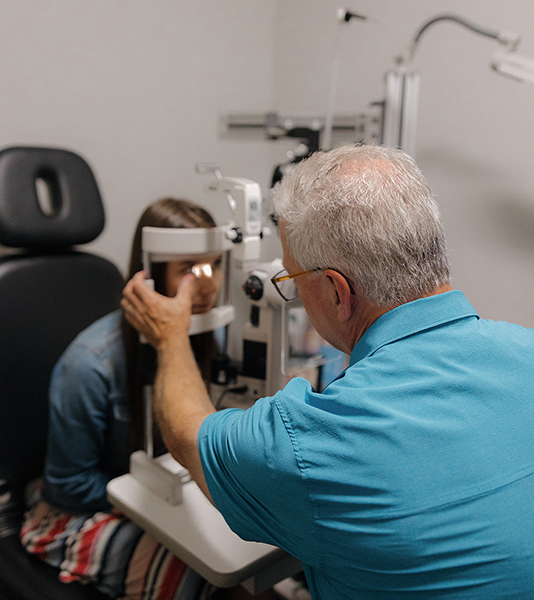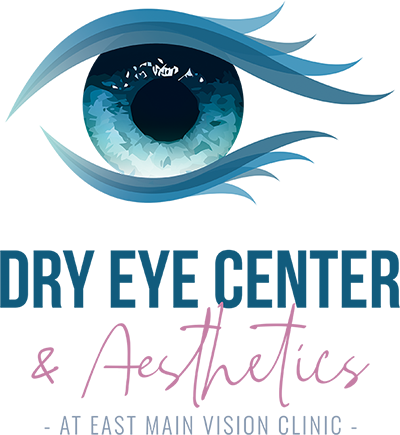Medical
Medical
Medical
Medical
Medical
We treat many eye related medical conditions
Optometrists like Dr. Day do much more than determine which is better, “One or Two?” Of course they prescribe glasses and contacts, as well as screen for serious eye related conditions, but Dr. Day also evaluates and treats many medical conditions that you may or may not have heard of, including:
Cataracts
Glaucoma
Hypertension (ocular)
Dermatochalasis (Drooping Eyelids)
Dry Eye Disease
Macular Degeneration
Diabetic Eye Disease
Vitreous Floaters
Visit our Specialized Testing page for more on these medical conditions.

This information is provided for informative purposes only.
Please see your optometrist or Primary Care Physician for diagnoses and/or treatment of any condition. If you have a serious or life-threatening eye emergency, please call 911 or proceed to an emergency room. Otherwise, call our office to speak with a triage technician who will help you determine how to proceed 2537800700.
If a Technician or Dr. Day has not called you back within 15 minutes, Proceed to the nearest emergency room for eveluation.
Common Eye Conditions
What is a Cataract?
A Cataract is a clouding or opacity of the natural internal lens of the eye, which causes a visual impairment.
The natural lens is located behind the iris, or “colored part” of the eye. The opacity may be a small dot or may involve the entire lens. The opacity in the lens causes the light entering the eye to be scattered, causing images to appear hazy or blurred. If your cataract is advanced, Dr. Day may suggest a surgical evaluation.
What is Glaucoma?
Glaucoma is an eye disease in which pressure increases in the eye due to clogged or blocked passages. Fluid that normally drains through these passages begins to build up, and the increased pressure can damage the optic nerve. Open-angle glaucoma tends to develop without warning–often painlessly and with no symptoms. Because of this, it can cause damage and blindness more quickly when untreated.
Risk factors for developing glaucoma include people over the age of 40, those who have a family history of glaucoma, those who are very nearsighted, diabetics, and African-Americans.
What is Macular Degeneration?
The most common symptom of macular degeneration is blurred central vision; noticeably worse when reading. In addition, horizontal lines may appear wavy and/or distorted. The most common method of detecting macular changes is the Amsler Grid test. During an eye examination, you are asked to look at the grid’s center dot and asked if you notice any wavy, distorted, missing, or broken lines on the grid. Any one of these irregularities may indicate changes within the macular region of the eye. Dr. Day will be able to confirm any suspicions of macular degeneration during a dilated retinal examination.
What is Dry Eye Disease?
There is no known cure for dry eye. However, some dry eye symptoms are caused by medications, eye infections or wearing contact lenses. In these cases, simply eliminating the cause of dry eye will stop the problem. In many cases, however, dry eyes are a lifelong problem. You can relieve the symptoms, but not cure the original cause. Most eye care specialists recommend artificial tear products (ocular lubricants) for their patients with dry eyes. Follow your eye care specialist’s recommendations in order to effectively relieve dry eye symptoms and avoid further damage to your eyes.
Visit our Dry Eye Center for more information.
What is Diabetic Retinopathy?
Diabetic Retinopathy is condition where a diabetic person’s blood sugar gets too high and damage occurs to the blood vessels inside the eye. Blood vessels in the eye are small and delicate and can easily be damaged. The damaged vessels can then leak fluid or bleed, causing the retina to swell and form deposits known as exudates.
How does my High Blood Pressure affect my eyes?
Hypertension, or high blood pressure, is a disease that can have serious effects on many parts of the body, including the eyes. Hypertension causes damage to the tiny and fragile blood vessels that feed the retina.
What can be done? To reduce the risk of hypertensive eye disease, regular examinations by a physician are needed to monitor the condition. Hypertension must be controlled as much as possible and the key to control is to follow the advice of your physician.
What is Keratoconus?
Keratoconus is a vision disorder that occurs when the normally round cornea becomes thin and irregular (cone) shaped. This abnormal shape prevents light entering the eye from being focused correctly on the retina and causes distortion of vision. Because the keratoconus cornea is cone shaped, light rays enter the eye at different angles, and do not focus on one point the retina, but on many different points causing a blurred, distorted image.
What is Conjunctivitis?
Conjunctivitis, commonly known as “Pinkeye,” is an inflammation of the conjunctiva, the clear protective membrane lining the inside of the eyelids and the white part of the eye. Conjunctivitis can be due to an infection (viral, bacterial or parasitic), or occasionally an allergic reaction, exposure to chemicals, or the result of contact lens wear.
Symptoms of conjunctivitis often include:
Redness in the white of the eye
Increased eye watering
Thick yellow discharge that crusts over the eyelashes, especially in the morning
Green or white discharge from the eye
Itchy or burning eyes
Blurred vision
Increased sensitivity to light
What is Blepharitis?
Blepharitis is a chronic inflammation of the eyelids. A common problem in both children and adults, blepharitis causes swelling, itching and irritation of the eyelids. There are several causes of blepharitis but the most common are seborrheic and Staphylococcus (Staph).
We are able to effectively treat Blepharitis with a gentle procedure called “Blephex.” Visit our Dry Eye Center for more information.
What are Vitreous Floaters?
Floaters are small, semi-transparent or cloudy specks or particles within the vitreous, which is the clear, jelly-like fluid that fills the inside of your eyes. They appear as specks of various shapes and sizes, threadlike strands or cobwebs. Because they are within your eyes, they move as your eyes move and seem to dart away when you try to look at them directly.
Floaters are most commonly the result of deterioration of the vitreous fluid, due to aging. As the eye ages, fluid moves out of the vitreous, causing it to shrink and develop clumps. These clumps of dried and aged vitreous are left suspended in the fluid and result in “floaters” in your vision. Floaters are usually not harmful (just frustrating), but they can sometimes be an indication of more serious issue like a retinal detachment.
A retinal detachment can occur when the vitreous shrinks and pulls on the retina causing it to tear off. The following are specific warning signs which are related to retinal detachment:
A sudden increase in the number of floaters in your vision.
Flashes of light in your side vision which you cannot explain.
A shadow or curtain coming over or across your vision (this could be in any direction).
IF YOU NOTICE ANY SIGN OF RETINAL DETACHMENT, EVEN IF IT IS ONLY ONE OF THE SIGNS MENTIONED ABOVE, YOU SHOULD CONTACT OUR OFFICE OR OTHER EMERGENCY SERVICE PROVIDER IMMEDIATELY!
What are Corneal Disorders?
The human cornea is the transparent front part of the eye that covers the iris, lens and pupil. There are many different disorders that can affect this highly sensitive part of the eye including injuries such as abrasion and lacerations, as well as chronic problems such as corneal dystrophy.
The cornea can be greatly impacted by contact lens wear; if contact lenses are worn longer than recommended, or are not handled properly, the cornea can show signs of “Overwear Syndrome,” which can affect vision.
What is a Stye?
A Sty (or Stye) is a small pimple-like growth appearing on the eyelid margin near the root of an eyelash. Styes are also referred to as a hordeolum and can be internal (inside the eyelid) or external (outside the eyelid). Treatment usually includes hot compresses and antibiotic ointment, but occasionally need to be excised and drained.
A Chalazion is a cyst on the eyelid that is caused by inflammation of a blocked meibomian gland. Chalazia are usually painless nodules and usually occur inside the lid rather than on the lid margin.
What are Ocular Allergies?
If you have ever had hayfever during the springtime, you may have experienced ocular allergies. Usually symptoms include itchy, watery eyes, burning or stinging, redness and sometimes blurred vision.
If you think you’re experiencing ocular allergies, it is important to see Dr. Day to rule out other causes of these symptoms.
What is Iritis?
Iritis is the inflammation of the uvea, the colored layer of your eye that lies between the inner retina and the outer fibrous layers. This is an eye emergency which requires medication and close monitoring to ensure it does not cause any lasting damage or vision loss.
Iritis can be very painful and cause a host of other symptoms including:
Redness of the eye
Blurred vision
Photophobia or sensitivity to light or glare
Irregular pupil
Floaters, which are dark spots or strings that float in the visual field
Headaches
If you experience symptoms of iritis, call our office immediately.
What is an Ocular Migraine?
Ocular migraines are usually painless with temporary visual disturbances that can affect one or both eyes.
Painless ocular migraines can appear suddenly, creating the sensation of looking through a cracked window. You might see a small, enlarging blind spot in your central vision with bright, flashing or flickering lights or wavy or zigzag lines surrounding the blind spot. The blind spot usually enlarges and may move across your field of vision.
Though they can be frightening, ocular migraines typically are harmless and self-resolve without medication within 20 to 30 minutes.
Ocular migraines are believed to have the same causes as migraine headaches. 70 percent of people who suffer from the disorder have a family history of migraines. Imaging studies also have revealed that changes in blood flow to the brain occur during ocular migraines and visual auras, but the underlying cause for these changes is not known. Additional triggers may be related to food, stress and blood pressure.
Always speak with a health care professional such as your primary care doctor or Optometrist when symptoms arise and an evaluation is recommended. It is important to speak to a medical professional about your symptoms in order to rule out more serious conditions such as stroke.
Contact Us
For non-urgent appointments, please call or send us a message, and we will be happy to help you select a customized appointment time.
Call us at 253-444-2800 if you are experiencing an eye emergency.

© 2025 East Main Vision Clinic - All rights Reserved - Sitemap - Privacy Policy - Accesibility Statement - Powered by: 

